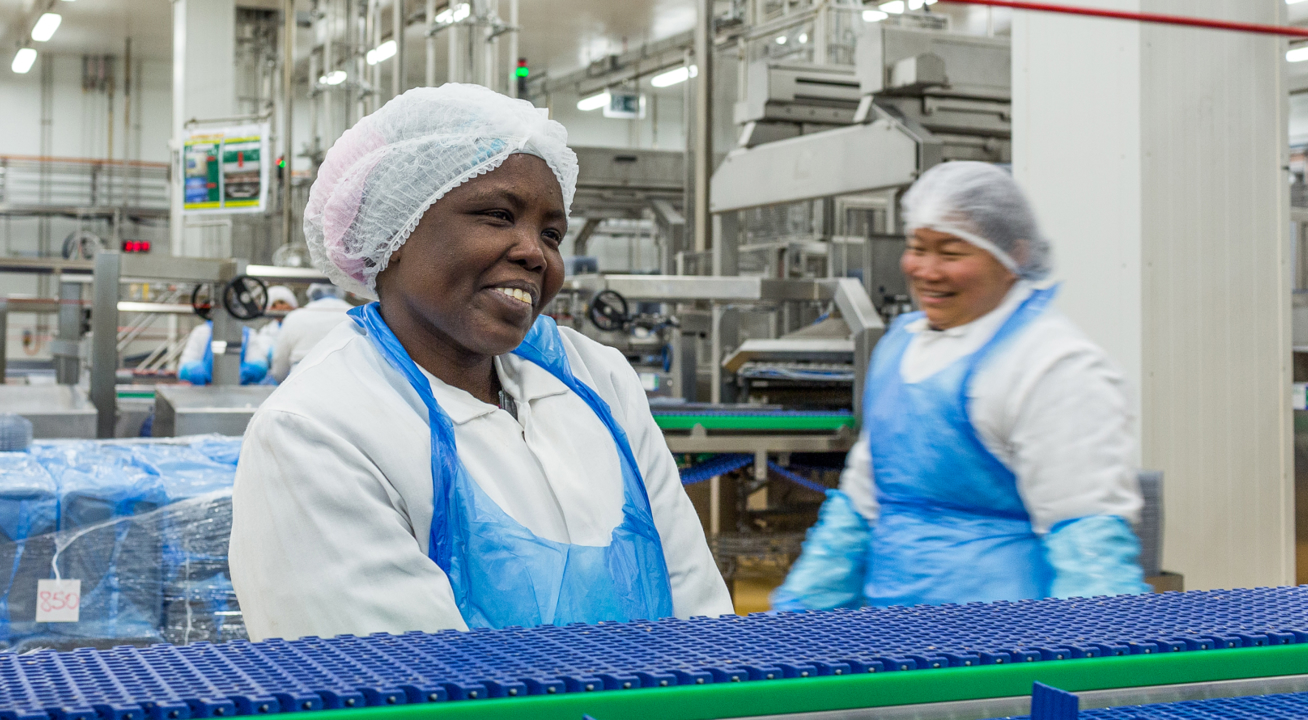In this blog we explore how food and drink businesses can proactively manage risk and build resilience amid rising tariffs and global trade disruption.
Few industries are as dependent on the smooth passage of goods across international borders as food and drink.
It’s been estimated that some 20% of the world’s food crosses at least one country line on the way to its final destination. Borders have long been considered weak points in global supply chains, adding time, complexity and cost to shipping goods from A to B.
But, in recent years, the impact these dividing lines have had on supply chain resilience has worsened considerably, as the political clashes with the geographical.
Trump’s wielding of tariffs as a geopolitical tool in his rivalry with China (among others), ongoing sanctions imposed in response to the Russia-Ukraine conflict, Middle Eastern volatility and even a lack of clarity in UK-European relations five years after Britain’s exit from the European Union have all had repercussions in recent times. So much so in fact, that global food and drink businesses are now facing significant additional uncertainty at international borders.
It has now got to the point where some 48% of supply chain leaders rank rising tariffs and trade barriers as their top international trade challenge, according to a 2024 survey by Descartes Systems Group,
So, what steps can concerned businesses take?
Well, the good news is that, though tariff and trade decisions lie largely outside food and drink’s field of influence, there are plenty of ways to limit their impact on your business.
Understand your level of exposure
It might sound obvious, but ensuring you have clear, granular visibility on where all goods originate, their shipping routes and how they are classified is the first critical step in being able to understand how your business could be impacted by any new or revised tariffs.
First, use this information to triple-check current classifications
Determining the country of origin of a product, for example, can dictate whether or not it is eligible for preferential tariff rates, including free trade agreement rates. Pay close attention to the application of legal principles like the substantial transformation test, which categorises country of origin based on the level of processing at each point in the supply chain.
Second, highlight those supply routes that pose the biggest risk
You are looking for routes that if disrupted could halt your operations. Considerations here are the volume or value of the goods being moved and the fact the route may act as a linchpin. This may apply, for example, if a business sources a core ingredient from a single supplier.
Work out viable alternatives
Diversifying supply bases for these most critical shipping routes is one option.
Doing so provides businesses with an existing relationship to turn to if new tariffs are imposed or trade tensions begin to impact a primary supply route. Since COVID-19, supplier diversification is increasingly common. Nearly two-thirds (62%) of businesses have already made these sorts of changes since the pandemic, according to EY, reporting higher levels of resilience as a result.
There are cons to bear in mind. Spreading orders across a higher number of suppliers often ends up adding cost. This can be the result of lower order quantities and added complexity, as supply chain leaders juggle multiple supplier relationships (often on more flexible contracts) while ensuring product quality remains consistent.
Each business will need to take this into account, balancing the benefits of greater resilience with the burden of a more complex supplier ecosystem.
It isn’t only suppliers that companies may want to diversify, of course. Where new import tariffs are imposed on goods, as is the case in the US, firms may also need to reappraise international expansion plans, diverting their attention to new markets, even if temporarily, to avoid additional costs.
Use technologies to forecast volatility
Reliance on manual forecasting – a task often designated to a single team member who then swots up on all relevant global news – simply doesn’t cut it any longer when it comes to managing future risk.
There are now incredibly sophisticated, accurate and (increasingly) cost-effective technological tools that can help businesses better identify what political rumblings they should be paying attention to.
AI-enabled tools can gather and digest huge reams of data from traditional news, social platforms and government reports to identify emerging political risks in a fraction of the time it would take a member of the team.
Traditional scenario planning can also be embedded with predictive analytics tools that lay out all the divergent paths that might be taken, allowing companies to significantly boost their preparedness.
And centralised data-managed systems can help food and drink firms make sense of the vast quantities of information they might be presented with, spotting patterns, highlighting discrepancies and sharing insights.
Create cross-functional response teams
The above steps can help companies strategically reshape supply chains to minimise their exposure to trade and tariff volatility. But, in some scenarios, no amount of clever manoeuvring or reclassifying can mitigate the impact of a sudden tariff hike.
When that happens, companies may need to consider how they respond at a product level. This could mean passing on a proportion of the additional cost to customers or consumers, adjusting formats, such as the volume of packs, or even considering reformulations to minimise reliance on a particular commodity or supplier.
These decisions go far beyond the purview of operations teams alone. Instead, they require a collaborative approach, with input from product development, account management and communications teams to name but a few. If you assemble these cross-functional response teams in advance and meet regularly to brief appointed representatives from each department on the latest developments, then they'll be primed to give input when needed.
Insure against worst-case scenarios
Finally, businesses may want to consider additional insurance that protects them against the impact of unexpected changes in tariffs. Most commonly this would take the form of what is known as Trade Disruption Insurance or Supply Chain Insurance. These often-bespoke policies typically focus on losses due to unexpected occurrences like trade disruption, regulatory changes or political events.
Such protections often don’t come cheap however, and so – once again – companies will need to carefully weigh up whether the cost outweighs the risk.
Control the controllable
Though food and drink businesses can often feel they’re at the whim of political decision-makers, there’s plenty you can do to protect yourselves against the brunt of these decisions.
Choose to combine your strategic supply chain mapping with the latest forecasting tools to understand future risk. This will enable you to establish a cross-functional nerve centre to respond quickly when disruptions do arise, reducing your exposure and increasing your chances of passing across international borders (relatively) unscathed.
Overcome your supply chain visibility and traceability challenges with our Supply Chain Mapping tools. To learn more, download your free brochure:
.png)
Foods Connected
Foods Connected is an award-winning cloud-based software platform that simplifies the food industry supply chain, optimising spend and unlocking the data businesses need to excel. Fast to roll out and even easier to use, our tools help our customers manage and report on traceability, product lifecycle management, procurement, quality control and sustainability.
Stay up to date
Stay up to date
Browse Posts
- December 2025
- November 2025
- October 2025
- September 2025
- August 2025
- July 2025
- June 2025
- May 2025
- April 2025
- March 2025
- February 2025
- January 2025
- December 2024
- November 2024
- October 2024
- September 2024
- August 2024
- July 2024
- June 2024
- May 2024
- April 2024
- March 2024
- February 2024
- January 2024
- December 2023
- November 2023
- October 2023
- September 2023
- August 2023
- July 2023
- June 2023
- May 2023
- April 2023
- March 2023
- December 2022
- November 2022
- October 2022
- September 2022
- August 2022
- July 2022
- June 2022
- May 2022
- April 2022
- March 2022
- February 2022
- January 2022
- December 2021
- November 2021
- October 2021
- August 2021
/Blog%20Headers/Blog%20header_Supply%20Chain%20Resilience%20Series_Navigating%20trade%20tensions.jpg)

/Blog%20Headers/shutterstock_1927957907%20(1).jpg)
/Blog%20Headers/shutterstock_1845178195%20(2).jpg)
/Blog%20Headers/shutterstock_2473376713.jpg)
/Blog%20Headers/shutterstock_2133827717%20(1).jpg)
/Blog%20Headers/shutterstock_2247276303.jpg)
.png)
.png)



/Blog%20Headers/Whitbread%20CS%20Blog%20Header.jpg)
.png)

.png)

/Blog%20Headers/shutterstock_1794185881.jpg)
/Blog%20Headers/Duncan%20Spencer%20Brown.png)

.jpeg)